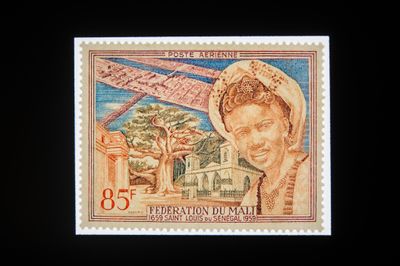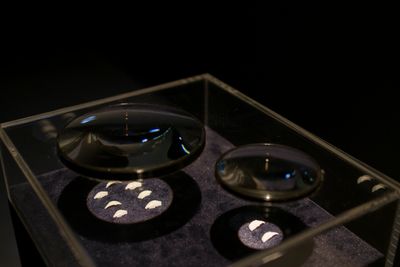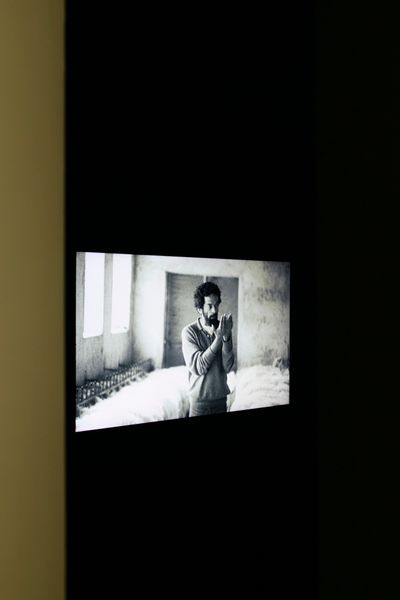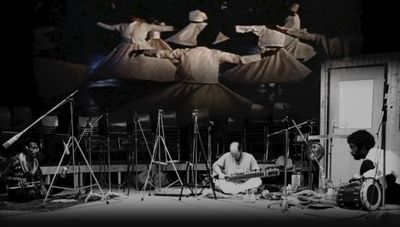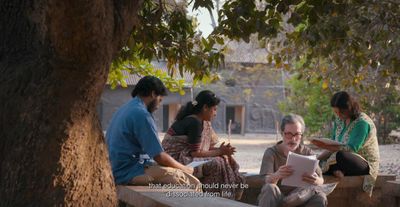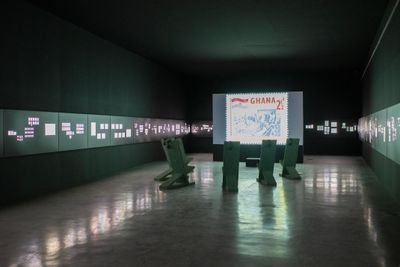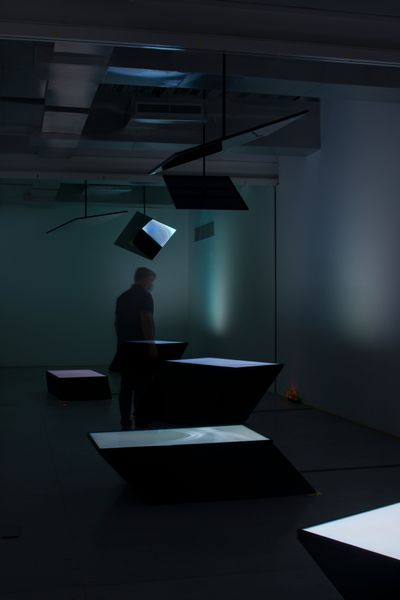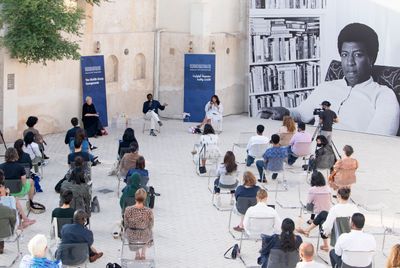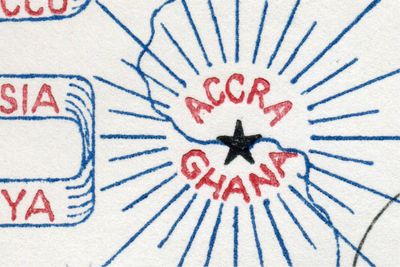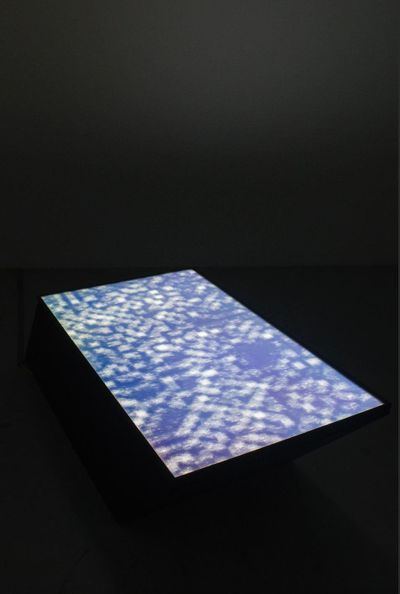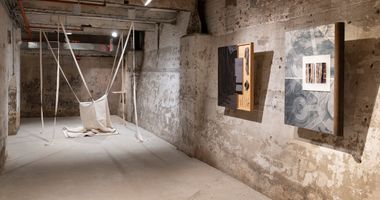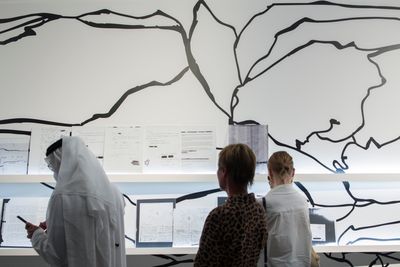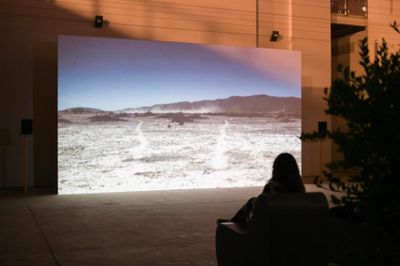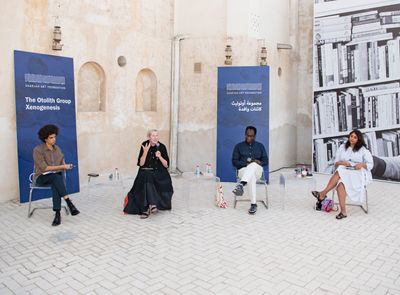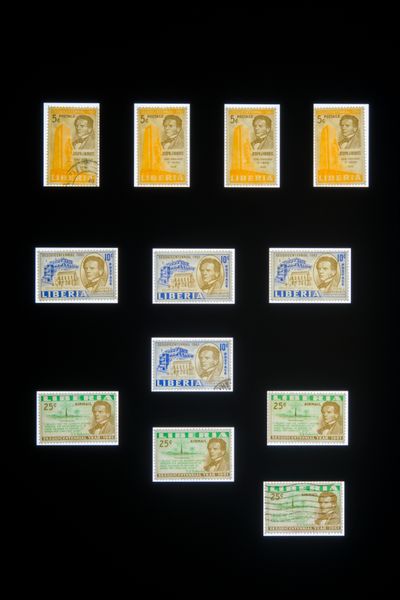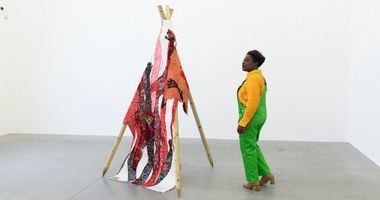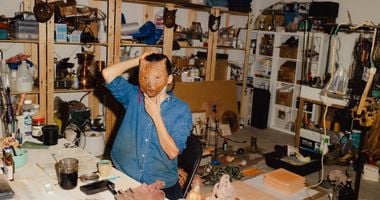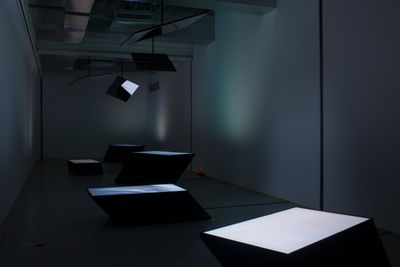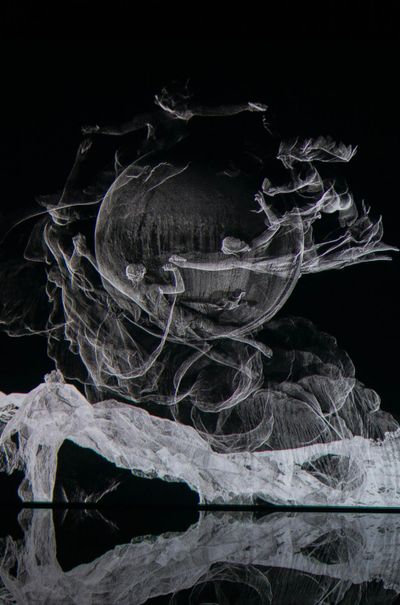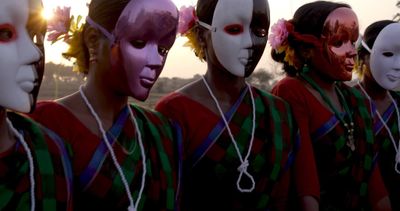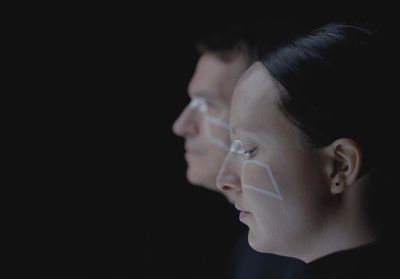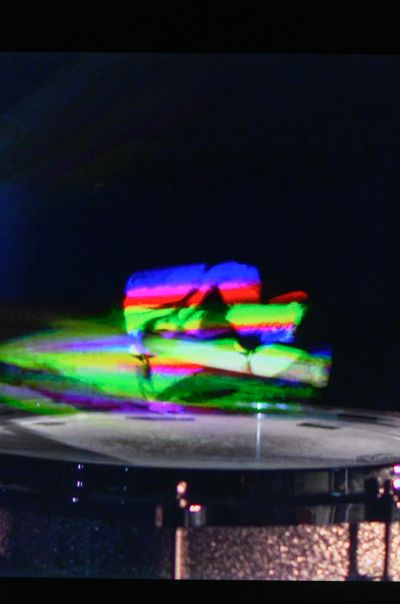The Otolith Group's Science Fiction of the Present
Left to right: Kodwo Eshun and Anjalika Sagar, The Otolith Group. Courtesy the artists.
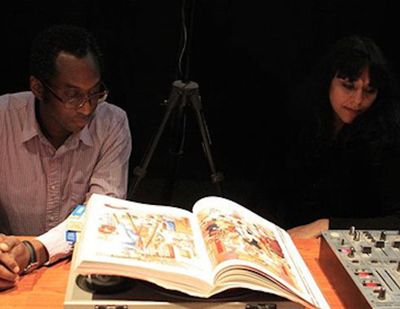
Left to right: Kodwo Eshun and Anjalika Sagar, The Otolith Group. Courtesy the artists.
In the context of an expansive practice that weaves archival and contemporary images and sounds, The Otolith Group blends poetry and fiction with the documents of lived histories to conceptualise speculative, inclusive futures and languages of becoming.
The artist collective and non-profit organisation was founded in 2002 by artists and theorists Anjalika Sagar and Kodwo Eshun, who operate across the fields of research, art-making, performance, writing, curation, and discursive programming to explore vital political legacies that continue to haunt the present.
Video essays like In the Year of the Quiet Sun (2013) and Nucleus of the Great Union (2018) look at Pan-Africanism through the lens of an arrested futurism, confronting a contradictory sense of disillusionment and hope that is reflected in the non-aligned images and perspectives the collective translates into video essays woven through with tapestries of sound.
'We looked at the Bandung and Pan-African moment through a post-disillusionment lens because we were born after,' Sagar and Eshun explain.
Born in 1968 and 1966 respectively, both artists are of transcultural heritage and grew up in London at a time defined as much by the racism of Enoch Powell as by the radical politics of Stuart Hall and the Black British Arts movement. They met in 2001 just after the 11 September attacks on the World Trade Center in New York.
In this interview, the collective talk about approaching the histories of Pan-Africanism, and beyond that, of Non-Alignment and Third Worldism, 'from the end backwards, and through a certain kind of received pessimism'.
Nucleus of the Great Union, for example, recovers the unpublished photographic archive of Black American novelist Richard Wright, shot during his first trip to Africa in 1953, where he witnessed the rise of Kwame Nkrumah's Convention People's Party, West Africa's first mass socialist party, as it campaigned for independence against British rule.
These photographs were to be included in Wright's text Black Power: A Record of Reactions in a Land of Pathos (1954), which addressed the author's 'existential alienation from the Gold Coast', and challenged the concept of racial belonging and Pan-African politics by invoking a Fanonian view of class, and the implications of colonised elites unable to break free from structures of colonial power.
Similarly, In the Year of the Quiet Sun, whose title refers to the phenomenon of the solar surface temperature cooling every 11 years, explores the contradictions of post-independence politics in Ghana.
The film focuses on magnified details of postage stamps, maximising their iconoclasm to zoom in on the political ceremony of independence, and the making and unmaking of polity on a continental scale. What is revealed is political instability on the ground: military coups against governments in Nigeria and Ghana, uprisings in Zanzibar, and a crisis of sovereignty in Congo.
Other works look beyond the nation-state to explore histories of transnationalism at a human scale. Created from solarised and colourised black-and-white photographs, the video essay People to be Resembling (2012) effectively presents a concrete methodology for togetherness located in the band Codona, founded in 1978 by three musicians from different cultures: Collin Walcott, Don Cherry, and Naná Vasconcelos.
'For us, Codona stands as a scale model for a sonic ecology or philosophy,' The Otolith Group explains. 'We wanted to evoke that through these photographs—to make music the substance of the work, not just its subject.'
People to be Resembling and In the Year of the Quiet Sun are among the works included in the travelling exhibition Xenogenesis, which unfolds at its final destination, the Irish Museum of Modern Art (IMMA) in Dublin, from 7 July 2022 to 12 February 2023, after launching at the Van Abbemuseum, Eindhoven, in 2019.
In 2020, the show, which was curated by IMMA director Annie Fletcher, travelled to Buxton Contemporary, Melbourne; Institute for Contemporary Art at Virginia Commonwealth University, Richmond; and Southern Alberta Art Gallery, Lethbridge. In November 2021, an iteration of the show opened at the Sharjah Art Foundation, co-curated by Hoor Al Qasimi, before opening at the Museum of Contemporary Art Metelkova, Ljubljana, in 2022.
Works in Xenogenesis include O Horizon (2018), a film portrait of Visva-Bharati University in Santiniketan, West Bengal, established by the polymathic Pan-Asianist Rabindranath Tagore in 1921 to recuperate forms of knowledge lost due to colonisation. Everyday life on campus is opened up to a vertical passage, with the camera continually moving from the ground to the sky and back.
The Otolith Group discuss O Horizon and other projects in this conversation, which considers the collective's 21st-century practice within the historical trajectories of Afro-Asian solidarity in the 20th century, including the Black British Arts movement.
SBThere is one line from In the Year of the Quiet Sun, which describes Ghana's first president Kwame Nkrumah as a tsar at home and a Leninist abroad.
Is there a conceptual bridge here to Nucleus of the Great Union, not just in terms of the Ghana focus, but because you don't take a simple position when it comes to the promises of Pan-Africanism, the Bandung Conference, and the Non-Alignment Movement?
ASThere is nothing simple about tricontinental movements, transnationalism, and independence struggles. The sense of a great shift and with it a great loss was present for us in 2001 and we wanted to experiment with finding a language to hold open critical questions.
Having met just after 9/11, we knew the event had re-ordered the future by aligning the global axis differently, while structuring violence and fear based on an internal enemy. Being the descendants of those involved in non-aligned histories and were active in independence and post-independence movements in India and Ghana, the epochal shift was both mortifying and conjunctive.
We therefore set ourselves the challenge of thinking on political conjunctures in terms of 'science-fictioning the present', to introduce a textured gaze into chronopolitical temporalities. Microgravity, as our first challenge, embodied gravity as a pressure and served as an artificial environment that opened scales of time in all directions and enabled us to think in terms of non-aligned images and sounds.
The idea of the essayistic offered a way to think in relation. We felt ourselves to be new mutants; we stand by this insight.
SBWhat's striking is that you're maintaining the space opened by the era of Third World liberation, which overlaps with the work of Stuart Hall, who understood political Blackness from an Afro-Asian, diasporic, anti-imperialist perspective, and as a means to create space for an actual, post-colonial future undefined by essentialist politics.
In some ways, Hall's position connects with Richard Wright's, whose critique of the Ghana independence movement, which you focus on in Nucleus of the Great Union, was a difficult position to hold in times of anti-colonial, pro-nationalist thinking; it complicates narratives surrounding the anti-imperialist struggle, which speaks to your practice, too.
How do you hold this space?
KERichard Wright characterises the books he wrote in the last decade of his life as an evocation of 'the tragic plight of the industrialised elite.' Wright casts the people he meets during his travels in Indonesia and the Gold Coast as world-historical figures caught in a drama of tragic grandeur.
We wanted to set that mode of pathos within differentiated timeframes. One was Afro-pessimism as Kobena Mercer writes about it—which is not the sensibility made popular by Frank B. Wilderson III, nor the foreign policy pessimism of white American journalists like Robert D. Kaplan.
Afro-pessimism, according to Mercer, is a poetics of disillusionment that ensues when independence is blocked, and Pan-Africanism is undermined from within, and without the nation-state.
To liberate and unify the continent required altering the world. In that sense, Pan-Africanism was a project with planetary implications.
We looked at the moments of Bandung and Pan-Africanism from a perspective after Afro-pessimism—historically speaking, we read them backwards from a point after the coups and the counter-revolutions that brought them to a halt.
We began to understand Pan-Africanism as a futurism arrested by its internal and external opponents—an idea that argued that changing the African continent entailed changing the capitalist world system. To liberate and unify the continent required altering the world. In that sense, Pan-Africanism was a project with planetary implications.
SBIn the context of this arrested futurism, the history of the Black British Arts movement in the U.K., which was eclipsed by the rise of the YBAs, runs almost parallel to Third Worldism and the neoliberal counter-revolution that would suppress it.
ASThe Black British Arts movement of the 1980s was made up of artists, writers, critics, filmmakers, and theorists collaborating, arguing, and building aesthetic weapons to navigate the segregation of the art sector. The so-called 'Young British Artists' promoted the idea of the celebrity artist, which made the idea of the collective seem old-fashioned.
The idea of seeing art as a fast track to celebrity entailed the erasure of the kind of movement building that mattered to us. What seemed to be a privilege for some and an opportunity for others implied a huge loss for us.
KEOne way to think about your question is to ask: What if neoliberalism started at different times in different places across the world? In the African continent, you could point to the coup in Ghana in 1966. In South America, it would start in Chile in 1973. In Europe, it might be 1992.
ASFor Iran, it would be 1953.
KEIn Ghana, you could argue that neoliberalism works by rolling back the political imagination of the Pan-African project. What you see in In the Year of the Quiet Sun is a parallax vision of Pan-Africanism—its arrested futurism, disillusion, and disenchantment.
Works like Nucleus of the Great Union and In the Year of the Quiet Sun are not filmed; we are putting images and sounds together to build post-cinematic timelines. What you get is a speculative perspective.
In terms of Stuart Hall's thinking, we can see that the coalitional Blackness that he and many others called 'political Blackness' was contingent, unstable, and fractious. You could say that coalitional Blackness inherited Pan-Africanism's ambition to create a unity articulated in difference.
In our work, we ask ourselves what the aesthetic implications of those questions might be from the perspective of the present. We are speculatively reimagining these ideas from the fragments we inherit.
SBOn the subject of disillusionment and arrested futures, Adom Getachew's book Worldmaking after Empire (2019) insists that, while the post-war postcolonial moment ultimately collapsed, this doesn't take away the radicalism of that time, when independent African nation-states entering the U.N. mobilised towards actual decolonisation in the 1960s and 70s.
KEYou're right. Worldmaking after Empire analyses in painstaking detail how the so-called newly independent nation-states were trapped by the dilemma of de facto political independence and de jure economic dependence from the very start.
The Pan-African idea of a United States of Africa intended to resolve this dilemma of political independence and economic dependence by unification through federalisms and federations. Each newly formed government that embarked upon this project found itself up against the limitations built into the political form of the nation-state.
The Cultural Cold War indicates what is at stake in the moment of independence, which is simultaneously the moment of the Cold War.
We can see the Cold War as a project to contain the implications of decolonisation as a planetary project in which newly independent states attempt to extricate themselves from the division of the earth between the U.S. and the U.S.S.R. by playing off the former against the latter in the interests of a non-aligned space of continental unification.
When Kwame Nkrumah said, 'We face neither East nor West: we face forward,' he was pointing to a third space. What were, and are the cultural implications of that direction? In these works, that is the question we are turning around and asking ourselves.
SBIt feels like The Otolith Group is located deep within that implicated cultural space, where histories continue to act in the present.
KEWhat if the Cold War never really ended? If the names changed, the organisations changed, but the effort to contain and circumscribe the political imagination, the political horizon, and the aesthetic horizon, did not?
A lot of the work we do is about thinking of and from the perspective of this planetary imagination. We draw on the idea of the interscalar vehicle as a way of travelling across scales of time, history, and space.
ASThe interscalar vehicle is how we think as a methodology of narration. It's how we travel and bring together every temporality we move through, from the data cloud to the centre of the earth. It's a methodology that reveals the multiple crime scenes of this world as they are.
But how does one work with that while producing forms of thought generated by the fact that the earth still sustains life?
KEIn these projects, these questions of magnification seek to recreate the scale of change posed by Pan-Africanism.
ASThe challenge is to find a narrative through these things; it's more about Non-Alignment in relation to thinking in vast scales that include the issues we face.
The interscalar vehicle is how we think as a methodology of narration.
Why and how are racial capitalism and climate change connected? There's still a need for work to speak to the challenges of creating a narrative in spaces where all genres are on repeat.
SBHere, we return to the planetary gaze you have talked about, which incorporates all possible contradictions of material reality—it's not just one dialectic, but infinite dialectics unfolding at once.
That relates to the question of how to negotiate a universal that doesn't demand a flattening into sameness, but acknowledges different, unique trajectories while engaging their intersections.
For example, in post-war Britain, Afro-Asian diasporas needed to form blocs against racism as the state maintained its structural order. But while it makes sense that these blocs have fragmented to now reckon with individual trajectories of collective, systemic trauma, this doesn't erase the necessity for a transnational political consciousness.
This all comes back to that intersection of Bandung, Non-Alignment, and political Blackness, and your own positions as artists who came of age amid the Black British Arts movement and who continue to follow these threads.
ASIt's a confusing time when you think about what something was or still is, and what it means to find aesthetic relations between different positions within differing cultures.
Somehow, India and South Asia tend to get left out of the idea of anti-colonial struggles or Blackness. As The Otolith Group, it does feel like the coalition between us challenges all kinds of people. Could it be that our existence evokes a history of rebellions that has always been multi-ethnic, and has emerged from the ports of empire, and the frontiers of imperialism?
SBDo you feel like there's an intersection between movements like Pan-Africanism, Non-Alignment, and political Blackness, which some artists associated with Black British Arts?
KEWhen you look back to that era, you can see the Black British Arts movement was pulling in different positions. Artists had, and still have very different ideas of what Black art is or should be, and of what Black aesthetics could or might mean, in terms of a movement around what people called 'Black British Art'.
Institutions tend to reward a kind of art that provides a form of certainty—about identity, the future, about history.
The question of what kind of art can do aesthetic justice to the kind of people 'we' are today, how we understand who 'we' are now historically, what kind of futures we want, and how we see the present, is not a settled question.
How to find a vocabulary for the kinds of frustrations that diasporic practitioners experience? How to give a shape and form to what Eric Williams called 'inward hunger'?
So many compelling theoretical formulations have emerged from the work of thinkers such as Saidiya Hartman, Fred Moten, and Denise Ferreira da Silva. What are the implications of these ideas from a Black-British perspective?
I think the so-called Windrush scandal offered us insight into the long duration of British racial capitalism. From this perspective, the so-called hostile environment of the Conservative regime enables us to grasp what Hartman calls the afterlife of slavery from the British perspective.
In the context of INFINITY minus Infinity (2019), the hostile environment is a way for us to travel back and forth in time—from 2012 to 2014, back to 1833, the so-called abolition of slavery.
SBThe afterlife of slavery relates to the ongoing transgressions reproduced by and through the system of historical capitalism.
Like how Asian indentured labour replaced slavery after its abolition by the British, and the enmeshment you draw out by unfolding historical time, which reflects the sensory and embodied burden of colonial experience, when there's really no such thing as positional purity.
KEI think it was Kobena Mercer who said diasporic art is not only transnational but translational—it's a translational aesthetic. You are always going through the metaphoric work of translation that is carried out between and within media.
Institutions tend to reward a kind of art that provides a form of certainty—about identity, the future, about history. If the work you make insists on problematising that certainty, then institutions will tend to sideline the work in the name of its audiences.
I understand that desire for clarity in moments of crisis, but I don't think we can afford the luxury of certainty anymore—however we define who that 'we' might be.
By placing quotidian gestures and spaces in an epic frame, we can begin to approach questions of ecology of the everyday.
Our work dramatises problematisation, which is difficult to deal with, because institutions tend to organise themselves around the satisfaction said to ensue from certitudes. That is not an option for those who are looking to make work that speaks to the problematics of our existence.
ASThis intersects with the realisation that the future is planetary and all of history is impacting 'right now'. How do you travel into this present? How does one contribute to thinking together and learning from our friends in the global south when populist authoritarianism wants to accelerate extinction.
Where the future feels apocalyptic, it's important to think about the un-implementable, as Ntone Edjabe (from Chimurenga) said. To me, this suggests an immanence that cannot be cannibalised, a power to fight destructive power through a preoccupation with the thickening of time, as the artist and writer Susan Schuppli describes—the 'evidential role of all matter as both registering external events and exposing the practices and procedures that enable matter to bear witness'.
SBThis mode of science-fictioning the present and thinking through sustainability speaks to O Horizon, which focuses on the experimental school Indian polymath Rabindranath Tagore established at Santiniketan.
ASO Horizon was made in relation to Tagore and the times of independence—the beating hearts of Indian modernism. It's important to say it is not a biography of Tagore. It's more about the cultural energy invoked in wanting to invent and restore a relation to the rural after its depletion by British imperialism.
Tagore was a romantic. I think one of his critical interventions was to create an environment for women to study art. To restore the relationship to the countryside, to craft and study, bodies and hands, and bring a Pan-Asian vision into culture.
KEO Horizon sets moments from everyday life on campus in Santiniketan and opens them up to a vertical passage in which the camera travels from the soil to the crown of the trees to the polluted sky, and back.
In a way, we try to shift from a reckoning with Tagore's history or biography towards a study of how students learn in the present. By placing quotidian gestures and spaces in an epic frame, we can begin to approach questions of ecology of the everyday.
That meant asking questions like how to film a tree so that it's not a background. Can we approach our cameras so that its presence becomes as important as a student's? So that the soil and sky have agencies that are distinct from, but not subservient to that of humans?
Thinking of the frame this way is part of how we approached O Horizon—its title speaks to that.
SB'O horizon' being the term for the layer of organic matter on the earth's surface.
KETo agronomists, a term like 'O horizon' is quite basic. For us, it was a revelation. The ways global climatic forces play out locally oblige audiences to think of the camera and the recorder as sensitising devices.
ASI think the question of sense is very important in the context of Tagore's vision for Santiniketan and Sriniketan.
SBDid Tagore's vision come through when you were there?
ASYou don't have that sense of it being a coherent experiment in anti-colonialism and restoring land. That vision is in the past.
We asked the sitting vice-chancellor of Santiniketan, who happened to be a Tagorean philosopher, to read Tagore's poem 'The Year 1400'. That poem starts by addressing a poet 100 years in the future. That provided an intertemporal structure to enter O Horizon.
We were interested in cohering the site in all its disparateness; to think about what it proposes as a thinking space for students. When we showed O Horizon at Santiniketan, some people said they never would have thought of placing drumming next to architecture.
There is a rhythmic energy throughout O Horizon that evokes the kinds of student activity throughout Visva-Bharati University, which speaks to Tagore's vision in the present, in which students take a class in Mandarin, Chinese and Santal dancers perform in Japanese noh masks.
SBDo you think there's a connection here with People to be Resembling (2012) and The Third Part of the Third Measure (2017), because music formally embodies that kind of collective dissonance?
ASYes, there is a kind of excess that emerges from Codona, from Don Cherry, Collin Walcott, and Naná Vasconcelos, in their relationships to their instruments.
All three were multi-instrumentalists. Their thinking space was a way of world-making that brought together different musical disciplines. Don Cherry thought of improvisation and instrumentation as tools that indicate how music opens spaces of feeling and thinking that are undeterminable and unthought.
The tensions of those instruments being brought together by different musicians, and the way they listened to each other, were important for us. It was very much based on improvisation, which for us, is a key to how sound invites listening across media. We have always sonified the image by approaching the moving image as a sonic image.
The idea is to make music the substance, as much as the subject of the work.
KECodona was a synthetic group that sounded organic; that's why they exert such an enduring fascination. They epitomise a migrant aesthetic. To bring together North-Indian tabla, Malian doussn'gouni, and Tibetan horns, to name just three instruments, and enable those different modes to speak to each other in a way that seems organic is quite something.
The effort in People to be Resembling was to make music with black-and-white photographs and photographic negatives that we solarised, colourised, and reversed. We treated Collin Walcott's quotation from Gertrude Stein's The Making of Americans (1925), which is on the back of the first Codona album, as a score for photographic permutation in which each Stein sentence suggests a different combination of still and moving images.
Everything comes together in that final scene. Charles Hayward conducts moving images with his drumsticks, and you can see visions of capoeira dancers generated and sustained by the rhythm.
For us, there is planetary thinking and an ecological ethos implied in Codona's music, in the way it combines so many divergent modes with such care. As an ensemble, Codona stands for a kind of sonic thinking we want to evoke through reassembling photographs as sonic images.
ASThe idea is to make music the substance, as much as the subject of the work. These are sounds that open frequencies of thought. And in those frequencies are their micropolitics. —[O]




